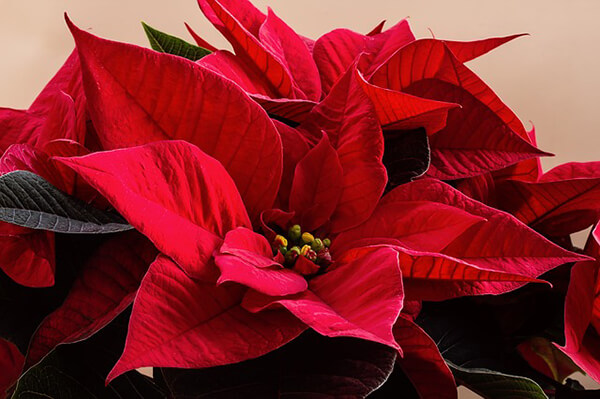Shopping for poinsettias is best during the Thanksgiving season, when selection is ample. To ensure that the plants are fresh, check the flower clusters in the middle of the bracts. If you see some yellow pollen, you do not want that plant. Have it properly wrapped so that it does not get exposed to low temperatures during transportation.
Irrigation
Feel the topsoil with your finger. If it is dry to the touch, water your poinsettias thoroughly. Place in the sink and irrigate until the water runs out of the bottom. Leave in the sink until the pot quits draining. If your poinsettias are located in warm locations or with a lot of light, the good rule of thumb is to check them twice a week. You do not want the poinsettias to dry out. If you allow them to wilt, the bracts will fall prematurely.
Temperature
Avoid windowsills that are drafty and cold. Likewise, avoid locating the poinsettias near heat sources. Avoid temperature fluctuations. The best indoor temperature for poinsettias is between 60ºF and 70ºF. Indoor nighttime temperature of 55ºF – 60ºF is very favorable for extending blooming periods. Nighttime temperatures of 75ºF can prevent the poinsettias from flowering. They can also cause decay.
Blooming Period
Ordinarily, poinsettias can last for up to six weeks before the bracts start falling off. In some cases, they can bloom up to six months. Do not fertilize poinsettias in bloom. If you want to keep them after the holidays, fertilize monthly with water-soluble fertilizer for houseplants.
Green Thumbing
Before you discard the faded poinsettias, try and cut off up to two-thirds of the stems, or up to where there is some new green budding. Do not repot. Place the poinsettia on a windowsill with a lot of sunlight. Water regularly, and avoid extremes in temperatures particularly cold drafts. For the poinsettias to re-bloom, prepare them in the fall. If you are bringing the poinsettias outdoor, choose a frost-free location with morning sun. They will need at least six hours of indirect light each day.
Re-blooming Poinsettias
Your poinsettias will require 12 hours of darkness at night and 12 hours of adequate light during the day, so you will need to move the pots back and forth. You can use your dark closet for nighttime, and your sunny windowsill during the day.
- Around April, your poinsettias will need half a day or more of sun (not mid-day heat). If you want more branches, pinch up to one-half of the new growth.
- Around June, you may repot. Choose a container about four inches larger than the original pot size. Use a soil mix with a considerable amount of peat moss.
- Pruning is appropriate during the summer months, but not after August.
- Around the first of October, you can move the poinsettias where it is protected from any artificial lighting during the night. Plan on as early as 5:00 p.m. If you need to, you can put it in a light-proof cardboard box. The slightest light infiltration will prevent poinsettias from flowering. About 8:00 a.m., locate it where it will receive up to eight hours of sun. You can bring the poinsettias indoor when it has reached the growth you want.
If you do not have the time, you are better off buying a new plant each season.
Poisonous or Not?
The American Medical Association’s Handbook of Poisonous and Injurious Plants, has reported that save some vomiting episodes, ingestion of poinsettia plants has not proven to be poisonous. Poinsettia sap, when ingested in large quantities, can upset the stomach. It is also a skin irritant. Along with other studies considered, the Consumer Product Safety Commission of the United States has denied a petition to require caution labels for poinsettias.








